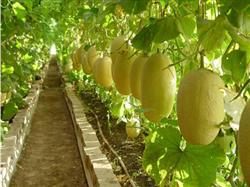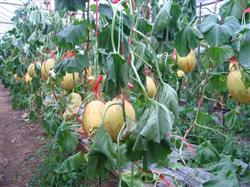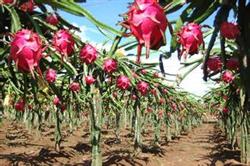Integrated control measures of Hami melon vine blight in rainy area

Vine blight mainly harms the stems of cantaloupe, as well as leaves, petioles and fruits. Stem vine infection, mostly in the stem nodes to form water-immersed spots, and then become grayish white to light reddish brown irregular necrotic spots. The petiole was infected and rotted in the form of water, and many small black spots were produced in the later stage, resulting in dry shrinkage and lodging of the plant. The leaf is infected, and the V-shaped brown spot is formed on the leaf edge, and the outer edge is yellowish, on which there is no obvious concentric wheel pattern. Fruit damage, the initial emergence of water-immersed disease spots, brown in the center, dried up as a star-shaped rupture, and finally rotted. Cross-cutting diseased stems showed that the vascular bundles did not change color, which was different from Fusarium wilt. Agricultural control chooses plots with high terrain and smooth drainage, and uses plastic film mulching with deep trench and high border (border height of 30 cm) to reduce soil moisture. Rotation with non-melon crops for 2 ~ 3 years, promote flood-drought rotation to reduce the number of pathogens. Basic application of mature organic fertilizer, increased application of phosphorus and potassium fertilizer and micro-fertilizer. Hanging vine cultivation, properly reduce the planting density, plant spacing of 60 cm, planting 1100-1200 plants per mu. Hami melon likes dry climate, and the humidity in greenhouse can be reduced by drip irrigation under plastic film. Watering should be carried out in sunny days, a small number of times, timely ventilation after watering. Pruning, branching, fruit thinning and topping in time to keep the shed ventilated and transparent. Chemical control is generally sprayed with 70% mancozeb wettable powder or 75% chlorothalonil wettable powder 600% 800 times, once every 7 days. At the initial stage of the disease, 25% prochloraz EC was sprayed with 1000 times, once every 5 to 7 days. You can also use 50% carbendazim wettable powder or 70% methyl thiophanate wettable powder and 25% carbendazim EC into a paste on a sunny morning, and apply it to the affected area and the wound left by pruning.
- Prev

Cultivation techniques of cantaloupe in greenhouse
In recent years, cantaloupe has been successfully introduced, demonstrated and popularized in Jiading, and a number of cantaloupe varieties suitable for cultivation in the eastern region have been selected, among which Xuelihong has become the leading Hami melon variety in this area. At the same time, through the "base + farmers" form, cantaloupe has been promoted to the majority of farmers, and has been formed.
- Next

Rational cultivation of dragon fruit to achieve high yield
1. Choose a place. The dragon fruit is resistant to drought and humidity, and is afraid of low temperature. It can be planted in areas with an annual average temperature of more than 20 ℃. The slopes with good drainage, fertile and loose soil layer, good aggregate structure but not sandy loam, sandy loam and clay loam should be selected for planting. The soil moisture should not be too high and the air permeability should be good, otherwise it will be perishable.
Related
- Moge, come on! The staff of the peasant association in the producing area of cantaloupe were frightened when the crowd gathered.
- Causes and Solutions of low Fruit setting rate of Apple
- Symptoms and control measures of passion fruit virus disease
- Fruit growing lesson: how do apple orchards keep high yields?
- Can you build orchards in the mountains? What are the pros and cons?
- How to manage the coloring period of Crisson grape?
- This paper introduces the processing technology of two kinds of fig products.
- How much is a month for retired teachers in rural areas by 2020?
- How can strawberry planting increase sugar content? We should pay attention to management in many aspects.
- What are the cultivation techniques on how to improve the yield of golden fruit?

